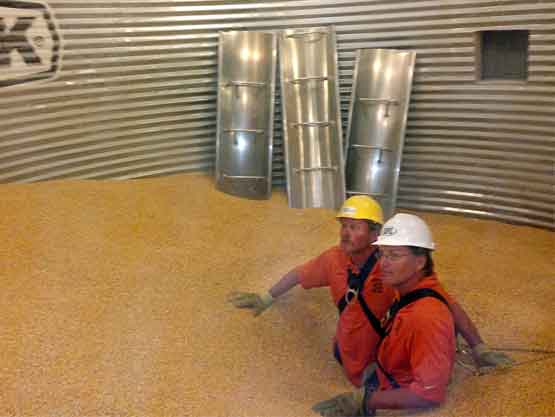How to Achieve Ventilation Drying and Low Humidity Storage in Grain Silo
Why Would Grain Become Mildew?
Moisture State of Inner Grain Pile
The inner grain pile generally has the phenomenon that the moisture always drifts away from the grain interior to its surface, then to the air in the clearance between the grains. In the process the moisture is very difficult to escape from non-flow air, instead it will gather in the grain pile. When the moisture reaches saturation point, it begins to coagulate, resulting in fermentation and temperature increase at some part. This will further prompt release of grain moisture and accelerate the corresponding fermentation process with the affection of dust and impurities, especially organic impurities that can speed up the process.

All the above processes and factors finally can form a serious threat to the safety of grain storage in steel silo.
Aerobic Respiration of Grain
Grain is the organism of life with breathing function. In a wide range of environment contacting with the air, grain will generate aerobic respiration with releasing carbon dioxide, water and heat. Glucose and other nutrients in grain will be consumed by oxidation. The chemical reaction equation is as follows:
Aerobic respirationC6H12O6+6O2 ——————→ 6CO2+6H2O+2.84(MJ)
Anaerobic Respiration of Grain
Under the anoxic condition, Grain will generate anaerobic respiration with releasing alcohol, carbon dioxide and heat. In internal grain it will happen on oxidation-reduction reaction. The chemical reaction equation is as follows:
Anaerobic respiration
C6H12O6——————→2C2H5OH+2CO2+0.12(MJ)
Respiration Hazards
When grain is low in moisture content and temperature, its respiration will decrease; when grain is high in moisture content, its respiration will increase. Meanwhile, grain respiration will also make its temperature and wet increased, which will accelerate the process of grain respiration. This is a vicious circulation, because it will provide enough conditions for grain mildew.
Ventilation cooling is an important means to maintain the stability of grain storage safety. Reasonable control of grain storage temperature is very important.
| Moisture (%) | Temperature against mildew | Temperature against pest | Grain germination (within 8 months) |
|---|---|---|---|
| 17 | 13 | <17 | 10 |
| 18 | 11 | <17 | 8 |
| 19 | 9 | <17 | 7 |
| 20 | 8 | <17 | 5 |
| 21 | 6 | <17 | |
| 22 | 5 | <17 |
Therefore, for steel silo, installation of ventilation system will improve the stability of grain storage, which can release accumulated heat in the grain pile through ventilation, reduce temperature difference between the inside and outside of the silo and prevent the moisture from drifting.
Safe moisture of grain refers to the maximum safe storage of moisture in a certain period of time without heat and mildew. Safe moisture can strictly control grain respiration and occurrence of mildew.
| No. | Item | Max. Safe moisture (%) | |
|---|---|---|---|
| 1 | Threshed corn, Sorghum | As a second-class grain for sale | 15.5 |
| Storage for 1 year | 14.0 | ||
| Storage for more than 1 year | 13.0 | ||
| 2 | Soy bean | For sale in spring | 14.0 |
| Storage for 1 year | 12.0 | ||
| 3 | Small grains (wheat, oats, etc.) | 13.0 | |
| 4 | Sunflower seeds | 9.0 | |
You Must Keep Grain Storage at Low Temperature in Steel Silos
To Lower Respiration Intensity of Grain
Grain storage at low temperature can lower grain respiration, thereby significantly reducing consumption of dry matter of grain. According to the relevant data, for 18% moisture of wheat, consumption on its dry weight under 10℃ is equal to 4% of corresponding part under 20℃, or 6% under 30℃; for 22% moisture of corn, consumption on its dry weight under 10℃ is equal to 31% of corresponding part under 25℃.
To Inhibit the Growth and Reproduction of Pests and Mildew
At the temperature of 5℃-10℃, for even 18% moisture of grain, storage fungi is very rare to be found there within 8 months; at below 0℃, most of fungi is dead. Therefore, when the temperature of grain storage is controlled under below 20℃, that can greatly lower pests; inhibit main pests under 17 ℃; Some pests will slowly go to die under 5℃-10℃. The optimum temperature of mite growth is limited in the range from 3℃ to 3l℃; under below 5℃, it will not grow and harm the grain.
To Delay Grain Aging to Maintain Fresh Quality
As we all know, grain storage at low temperature is conducive to the quality protection of grain and seed. Every time the temperature lowers by 5℃ (0℃-50℃), the seed's life will double it.
Ventilation System of Steel Silo
The ventilation system of the steel silo is advantageous to the safety of grain storage. Equipped with the fan on the top of the silo, the silo will adjust the temperature of the top space. Releasing the heat and moisture of the surface layer and the upper layer can adjust to inhibit harms by higher temperature.
The common ventilation methods include: ground trough ventilation, ground cage ventilation, single-pipe ventilation, multi-pipe ventilation, radial ventilation, vertical ventilation, pipe-less ventilation. No matter what ventilation mode it is adopted, we must confirm that the fan can blow its wind evenly into the grain to avoid wind can’t reach somewhere, in order to better guarantee ventilation effect and safety of grain storage.
In conclusion, in order to achieve the purpose of safety of grain storage, ventilation drying and low humidity storage of grain for steel silo must be implemented by ventilation system. The effective ventilation is the key way to reduce and balance grain temperature, avoid condensation, control pests, prevent heat, reduce expenses, etc.
Flyer Company can provide you with advanced ventilation equipments, which can ensure you to be satisfied with grain storage of steel silo in future. If you have any question, please feel free to contact us.
 Español
Español
